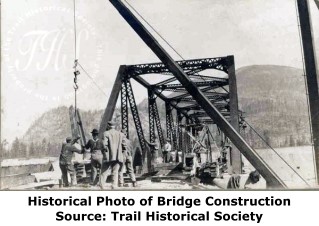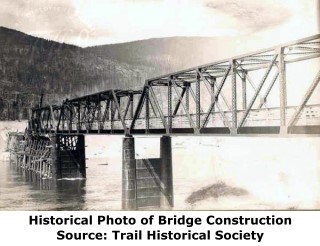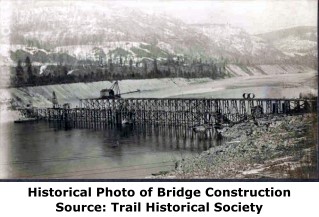We Recommend:
Bach Steel - Experts at historic truss bridge restoration.
BridgeHunter.com Phase 1 is released to the public! - Visit Now
Old Trail Bridge
Old Bridge

Primary Photographer(s): Nathan Holth
Bridge Documented: August 20, 2014
Trail: Kootenay Boundary District, British Columbia: Canada
Not Available or Not Applicable
174.0 Feet (53 Meters)
693.0 Feet (211.2 Meters)
Not Available
4 Main Span(s)
Not Applicable

View Information About HSR Ratings
Bridge Documentation
This bridge's future is at risk!
Bridge Status: This Heritage Bridge is Slated For Demolition and Replacement!View A Zip Archive of Documents Relating To The Demolition Project
View A Facebook Page About Saving This Bridge
View A City Website About Demolishing This Bridge
About This Bridge
This bridge is the older of two heritage bridges in the City of Trail. It has been closed to all traffic including pedestrians although it still carries a pipeline.
The bridge was erected by the Province of British Columbia in 1911. J. E. Griffith was the public works engineer. Archie Broderick was noted as an assistant engineer involved with the bridge.
The bridge rests on riveted steel caissons, which are filled with concrete. This type of substructure was common in certain regions such as the Midwestern United States where they were sometimes called "Lally Columns." The Trail Bridge's caissons have riveted plate which joins the two columns that form each pier, a detail not always found with this substructure type.
This bridge is historically and technologically significant as a relatively early rivet-connected truss bridge in British Columbia, and a good multi-span example of the type. Aside from some replacement of rivets with bolts, particularly on the bottom chord, this bridge retains good historic integrity with no major alterations.
More research would be needed, but the bridge may also be historically significant on additional levels if it played a role in developing the region, as there are few crossings of the Columbia River in this area, and so the bridge's construction may have provided an incentive for development in the area.
Bridges of this type are disappearing in British Columbia and Canada in general at an alarming rate, with very few of these bridges being preserved. The bridge will only become increasingly rare in the years to come if it is allowed to remain.
As a riveted metal truss bridge, the Old Trail Bridge has an attractive pattern of geometry that makes the bridge as a whole aesthetically pleasing. Viewed up close, additional geometry and the high level of detail that distinguishes bridges of this type can be seen. Numerous rivets hold the variously shaped gusset plates to the various truss members. The truss members themselves are not simple rolled i-beams, but instead riveted built-up beams that include aesthetically pleasing v-lacing. Bridges like the Old Trail Bridge are outstanding candidates for preservation for pedestrian use. They also can be readily rehabilitated for light vehicular traffic. In either case, the bridge offers beauty and heritage that cannot be found in any modern bridge.
Why the Old Trail Bridge CAN Be Restored!
Currently, this historic bridge is slated for demolition and replacement with a pedestrian bridge which would also carry the pipeline currently carried by this heritage bridge. This proposal is opposed by a number of people who have formed a Facebook page advocating for saving the bridge. In contrast, the City of Trail so badly wants to rid itself of this beauty and heritage that they have developed an entire webpage titled "Information on Trail's Old Bridge & Why it Can't Be Restored."
"Can't Be Restored" is a rather strong statement. It implies that preservation is not possible, that the bridge is so deteriorated that it would be unsafe or impossible to return the bridge to working condition. Based on review of the inspection reports, and comparison with preservation projects elsewhere, such a statement is absolute nonsense. If the city wants to create a website to advocate for the destruction of its heritage, they should more accurately name the website "Information on Trail's Old Bridge & Why it WON'T Be Restored." On this renamed website, the city should explain to its residents and taxpayers why the city has chosen to send this attractive piece of heritage to the dumpster, despite feasibility of preservation.
The city hired Buckland and Taylor consulting engineers to evaluate the bridge. Although the company is well-respected internationally and they have a large portfolio of new bridge construction, a review of their website does not list any substantial examples of successful rehabilitation of metal truss bridges. After receiving the company's report on the bridge, the city proudly displays a quote from the company:
"Results of the Old Bridge's annual examination clearly indicate the structure cannot be used in any way, shape or form due to severe deterioration. Combined deficiencies to the struts, piers and chord make the use of the old bridge structure, for pedestrians or vehicles, dangerous." - Buckland & Taylor Ltd., 2010
Yet a review of the inspection reports reveals a few things. Like most deteriorated historic metal truss bridges, severe deterioration is confined to the areas at and below the deck level. This includes the bottom chord, lateral bracing, etc. Because deterioration is common in these areas, historic preservation of metal truss bridges often requires repair or even complete replacement of these areas. In contrast, the majority of the truss, which is above the deck level, is in decent condition. Thus, even if everything at and below the deck level were replaced in rehabilitation, the historic integrity of the bridge would remain decent since most of the truss could simply be repaired. The Ramsdell Road Bridge in New Hampshire is an example of a truss bridge rehabilitated, albeit with a completely replaced bottom chord.
The inspection reports also note that the substructure is in severely deteriorated condition and is why the bridge was closed to traffic. The report claims the concrete within the riveted caissons is so deteriorated that the bridge is bearing on the riveted steel casing and it was noted that the concrete was not reinforced. It is not clear how it was determined that the concrete was not providing any bearing ability. The lack of reinforcing is not surprising. The riveted casing was designed to hold the concrete together, and reinforcing would not be needed. While it would be nice to preserve the substructure, it is the truss superstructure that makes this bridge significant, and so replacing the piers for the purpose of preserving the historic superstructure would be an acceptable outcome.
It is unclear why Buckland and Taylor are making claims that the bridge is impossible to preserve when clearly that isn't the case, even if all deterioration noted is assumed to be correct. Even if Buckland and Taylor is one of the many engineering firms that lack substantial experience with successful, completed rehabilitation of heritage bridges, Buckland and Taylor's experience with new bridge construction even suggests ways in which this bridge might feasibly be preserved but which have been ignored. Buckland and Taylor is very proud of their project where they reduced the historic Milton Madison Bridge to scrap metal. In this project, a new bridge was built next to the historic bridge, the historic bridge's trusses demolished, and the new trusses were slid over to rest on the piers of the historic bridge. The concept of sliding a bridge might be a way to preserve the Trail Bridge. New piers could be constructed next to the existing ones, and the bridge simply slid over to the new piers. Alternatively, if Buckland and Taylor could slide a bridge the side of Milton Madison, they certainly could figure out how to lift the Trail Bridge truss spans off the piers and bring them to shore, to both facilitate pier replacement, and also off-water or even in-shop restoration of the trusses, which would eliminate need for falsework in the river to facilitate replacement of deteriorated truss members.
Since the plan is currently to demolish and replace the historic bridge, it is already a given that a new substructure is going to be built for some bridge. Why not instead build a new substructure to support this heritage bridge?
The above photo had a note stating Archie Broderick, assistant engineer, is the man in the sweater.
![]()
Photo Galleries and Videos: Old Trail Bridge
Bridge Photo-Documentation
Original / Full Size PhotosA collection of overview and detail photos. This gallery offers photos in the highest available resolution and file size in a touch-friendly popup viewer.
Alternatively, Browse Without Using Viewer
![]()
Bridge Photo-Documentation
Mobile Optimized PhotosA collection of overview and detail photos. This gallery features data-friendly, fast-loading photos in a touch-friendly popup viewer.
Alternatively, Browse Without Using Viewer
![]()
Maps and Links: Old Trail Bridge
Coordinates (Latitude, Longitude):
Search For Additional Bridge Listings:
Additional Maps:
Google Streetview (If Available)
GeoHack (Additional Links and Coordinates)
Apple Maps (Via DuckDuckGo Search)
Apple Maps (Apple devices only)
Android: Open Location In Your Map or GPS App
Flickr Gallery (Find Nearby Photos)
Wikimedia Commons (Find Nearby Photos)
Directions Via Sygic For Android
Directions Via Sygic For iOS and Android Dolphin Browser








